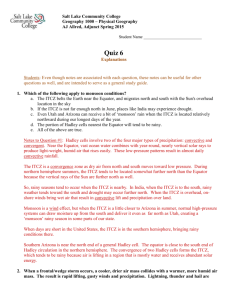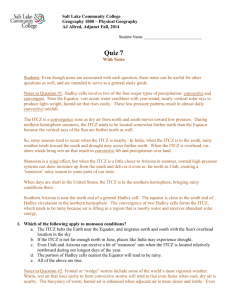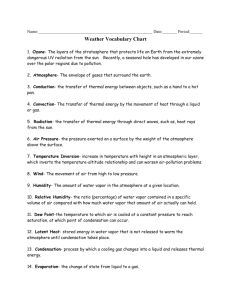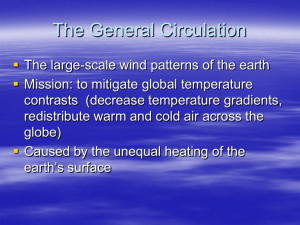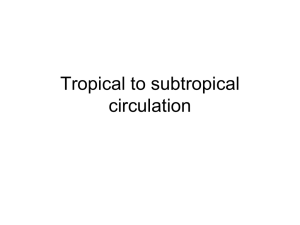Quiz 6 - SmartMap.us
advertisement
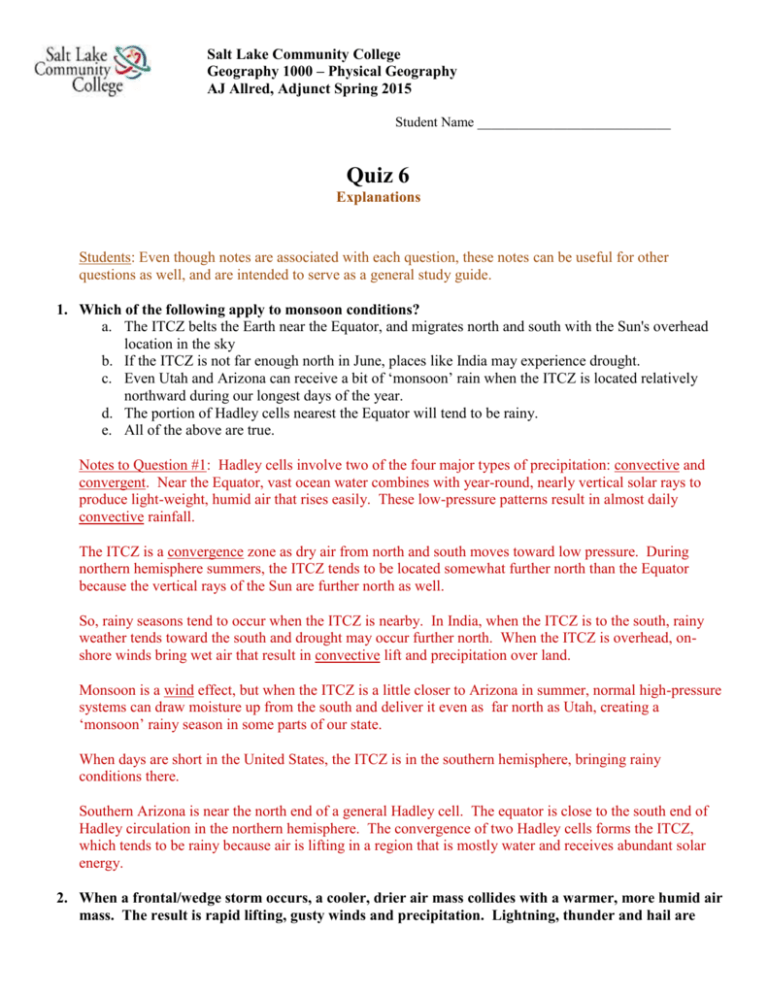
Salt Lake Community College Geography 1000 – Physical Geography AJ Allred, Adjunct Spring 2015 Student Name ____________________________ Quiz 6 Explanations Students: Even though notes are associated with each question, these notes can be useful for other questions as well, and are intended to serve as a general study guide. 1. Which of the following apply to monsoon conditions? a. The ITCZ belts the Earth near the Equator, and migrates north and south with the Sun's overhead location in the sky b. If the ITCZ is not far enough north in June, places like India may experience drought. c. Even Utah and Arizona can receive a bit of ‘monsoon’ rain when the ITCZ is located relatively northward during our longest days of the year. d. The portion of Hadley cells nearest the Equator will tend to be rainy. e. All of the above are true. Notes to Question #1: Hadley cells involve two of the four major types of precipitation: convective and convergent. Near the Equator, vast ocean water combines with year-round, nearly vertical solar rays to produce light-weight, humid air that rises easily. These low-pressure patterns result in almost daily convective rainfall. The ITCZ is a convergence zone as dry air from north and south moves toward low pressure. During northern hemisphere summers, the ITCZ tends to be located somewhat further north than the Equator because the vertical rays of the Sun are further north as well. So, rainy seasons tend to occur when the ITCZ is nearby. In India, when the ITCZ is to the south, rainy weather tends toward the south and drought may occur further north. When the ITCZ is overhead, onshore winds bring wet air that result in convective lift and precipitation over land. Monsoon is a wind effect, but when the ITCZ is a little closer to Arizona in summer, normal high-pressure systems can draw moisture up from the south and deliver it even as far north as Utah, creating a ‘monsoon’ rainy season in some parts of our state. When days are short in the United States, the ITCZ is in the southern hemisphere, bringing rainy conditions there. Southern Arizona is near the north end of a general Hadley cell. The equator is close to the south end of Hadley circulation in the northern hemisphere. The convergence of two Hadley cells forms the ITCZ, which tends to be rainy because air is lifting in a region that is mostly water and receives abundant solar energy. 2. When a frontal/wedge storm occurs, a cooler, drier air mass collides with a warmer, more humid air mass. The result is rapid lifting, gusty winds and precipitation. Lightning, thunder and hail are common. Even on a hot summer day, a thunderstorm often involves ice because convective cloud tops can reach extreme altitudes where air is frozen year-round. True ___ False ___ Notes to Question #2: Frontal or “wedge” storms include some of the world’s most vigorous weather. Warm, wet air that rises easily to form convective storms will tend to rise even faster when cool, dry air is nearby. The buoyancy of warm, humid air is enhanced when adjacent air is more dense and stable. Even with vapor-saturated air, freezing conditions are often found near the tops of thunderstorms. The standard lapse rates used in class discussion will indicate frozen conditions in clouds even when surface temperatures are very hot. For wet air that tends to be cooler by about 3.0ºF per thousand feet, ice will be found as low as 24,000 even when ground surface temperatures are 100ºF. 3. Evaporation is an effective way of absorbing or ‘hiding’ heat so that it can be carried away by convection. One result is severe storms in places far from the Equator and precipitation that helps prevent drought in sub-tropical regions. Without hurricanes and other severe storms Florida would suffer from drought. True ___ False ___ Notes to Question #3: Evaporation converts sensible heat (heat we can sense or feel) into latent heat that we can’t usually detect. Energy is not lost; it is converted to a different form. Loss of sensible heat results in lower measured temperature. That is the energy “price” that is paid in order to convert liquid water into invisible water vapor. Condensation has the opposite effect of evaporation. Energy that was hidden by evaporation returns when water vapor converts back to liquid water. This process is vital to understanding atmospheric instability: when air rises for any reason, condensation may occur, forming clouds in the sky and releasing latent heat back to heat we can feel and measure as higher temperature. Unstable air can result as release of latent heat causes air to rise more vigorously, perhaps releasing more latent heat each time humid air decompresses and cools with rising altitude. Strong or gusty winds may result, and rapidly rising air can promote formation of hailstones, lightning and thunder. Trade winds and ocean currents help move tropical heat and humidity to other places. 4. Utah hosts a few funnel clouds or tornadoes in an average year. To have more tornadoes we need: a. More water. b. More heat. c. fewer mountains. d. Closer proximity to the Equator. e. None of the above will help produce such severe weather. Notes to Question #4: Utah has plenty of atmospheric heat because abundant sunshine is seldom blocked by cloud cover. Ordinary thermal heat is measured as temperature, like “cash” in hand. Water vapor represents a latent, or hidden source of energy for more vigorous storms, like money on an ATM card. Utah already has enough heat to produce dust devils during warm weather. A tornado is much more powerful because it contains heat and humidity (evaporated water), which adds a great deal of energy to air that is already rising due to heat-caused buoyancy. Hurricanes are normal for “Mother Nature” in Florida. Millions of people living near the beach is not normal. Americans are gamblers and complainers. Utah is more likely to have dust devils on a hot day instead of a genuine tornado because hot air cools rapidly with altitude and there is not much humidity or water vapor available to condense back to liquid for more heat. In a sense, a tornado has heat as “cash” and latent heat as “credit”. Cash and credit are needed for severe weather. The world’s worst weather also needs contrasting cooler, drier air nearby to get even more effect out of rapidly rising humid air. 5. The U.S. region known as “Tornado Alley” in the United States is related to everything below except: a. The southeast USA is not dry like Arizona, even though it is located near sub-tropical high pressure Hadley cell flow. b. Westerly winds dry out as they cross the United States c. Trade winds move westward from Africa, “loading the gun” with heat and humidity d. Mid-latitude cyclones rotate clockwise while migrating westward with the jet stream. e. Meridional jet stream flow helps mix air masses that differ greatly in heat and humidity Notes to Question #5: Arizona is near the north end of a general Hadley cell. The Equator is proximate to the south end of Hadley circulation in the northern hemisphere. The convergence of two Hadley cells forms the ITCZ, which tends to be rainy because air is lifting in a region that is mostly water and receives abundant solar energy. Florida and Alabama should be dry like Arizona, based on simple Hadley cell flow, but they are not because trade winds bring humidity and rain westward from the Atlantic Ocean to the southeastern United States. The United States is unusual in that the southeastern states are humid rather than desert-like, even though they are located under the northern end of Hadley cells where descending, warming air should produce dryness. Instead, trade winds from the east bring latent heat in moist air. The jet stream from the west sometimes moves in a more north—south direction, helping to bring cool, dry air into contact with warm, wet air. The contrast between such air masses creates relatively greater buoyancy and more vigor in storms. Mid-latitude cyclones are a unique combination of dry-cool air colliding with warm-humid air. 6. In the northern hemisphere, cyclonic weather involves wind: a. moving counter-clockwise with rising air. b. moving clock-wise with sinking air. c. moving counter-clockwise with sinking air. d. that is sinking due to the weight of heavy water vapor e. All of the above are true Notes to Question #6: For class discussion and for most places in the textbook, references to cyclones and anti-cyclones tend to refer to the northern hemisphere where such air patterns are most common. Cyclones represent lower-pressure, rising air that turns counter-clockwise because of Coriolis force and pressure gradient. Water vapor tends to make air lighter, contributing to lifting by thermal low pressure. 7. The atmosphere warms mostly from the bottom because: a. Gravity makes air pressure and atmospheric mass more dense near the surface, providing more substance for absorbing solar energy. b. Dirt, rock and water at the Earth’s surface absorb much more solar energy than does thin atmosphere. c. The atmospheric ozone layer warms somewhat as it absorbs ultraviolet energy, but that absorption is only a small portion of overall Earth warming. d. Water vapor and liquid water have very high heat capacity, and nearly all water is located close to Earth’s surface. e. All of the above are true. Notes to Question #7: All of the above are true. 8. Which of the following statements is FALSE? a. A dust devil is low-pressure rising air that derives energy from hot surfaces below. b. A tornado is supplied with heat when rising humid air cools to condensation and produces clouds of liquid water. c. A dust devil is not associated with condensation of latent heat back into sensible heat. d. Condensation is the process of releasing heat so that air maintains buoyancy and keeps rising. e. Condensation is the process of absorbing heat, causing air masses to cool and stop rising. Notes to Question #8: Dust devils are mostly about relatively dry heat, and they subside quickly with altitude because air cools by decompression as it pushes into higher altitude. A genuine tornado also relies on rising air, but receives additional ‘lift’ when humid air aloft cools by decompression to a point where vapor saturation leads to release of latent heat. Condensation is the process of releasing heat that was absorbed when liquid water changed state to vapor. 9. The normal lapse rate of air temperature means that warmth varies inversely with altitude: the higher you are in the atmosphere, the lower your air temperature. Dry air is especially cold at high altitude because it contains relatively little latent (hidden) energy storage in the form of humidity (water vapor). True ___ False ___ Notes to Question #9. Everything is true. 10. Which of the following statements is not TRUE? a. Trade winds push hurricanes toward the east coast of the United States and away from the west coast b. The “Ideal Gas Law” would be more “ideal” if Earth had a “lid” on it. Instead, heated air just causes low pressure, instead of high pressure. Winds result. c. Trade winds are created by sub-tropical high pressure air masses and the rightward deflection of Coriolis force. d. Extra-tropical storms are a means of transferring heat away from the tropics e. Jet streams are the high-altitude part of trade wind flow that brings moisture to southeastern USA. Notes to Question #10. Jet streams are high-altitude wind moving west to east and are associated with the westerlies. 11. Which of the following statements is FALSE? a. Water in a freezer can evaporate and disappear because of vast amounts of heat that exist in frozen air. b. Evaporation and condensation are essentially the same process: they both convert sensible heat to latent heat. c. Clouds forming in the sky are the opposite of evaporation. d. All types of stormy weather (precipitation) involve air decompressing with altitude. e. Air sinking on the lee (down side) of a mountain will tend to warm itself adiabatically even if no heat is added. Notes to Question #11: Frozen air still contains thermal energy and can slowly evaporate water. Sublimation is the process whereby ice can go directly to vapor, skipping the liquid state in between. Clouds in the sky are liquid water that was released from latency when air cooled enough to reach vapor saturation. Answer ‘b’ is clearly wrong: evaporation and condensation are opposites. Evaporation hides heat in water vapor; condensation brings latent heat back to heat we can feel. Water vapor converts back to liquid water we can see. 12. Which of the following is false: a. Air blowing over a high mountain should be more humid after it descends to the bottom on the other side. . b. Energy cannot be destroyed, but it can be hidden when it evaporates liquids into vapor. It takes energy to turn liquid into vapor, but the energy is not lost, nor is the liquid destroyed. They are just hidden (latent) c. A ‘swamp cooler’ (evaporative cooler) converts heat into humidity. Heat and water are ‘hidden’ in the air d. Air blowing over a high mountain and down the other side is likely to be more dry than before it started rising over the mountain. That is why Utah receives relatively little moisture from Oregon and California. e. An electric hair dryer is basically an evaporative cooler: heat is used to evaporate water. Notes to Question #12: Typically, air rising over a mountain will leave some snow or rain on the windward, or rising side of the mountain. That precipitation requires condensation caused by de-compression cooling. Conversion of humidity back to liquid water releases latent heat that was stored when that water was originally evaporated. So, that added heat joins the air as it continues on down the other side, warming adiabatically by compression at lower altitudes. So, air temperature should be higher when air reaches the base of the mountain on the dry side. 13. Based on purely conceptual understanding from class discussion, which of the following statements is true? a. On a very dry day, air temperature at 10,000 feet should be about 50 degrees cooler than air at the surface directly below. b. In vapor-saturated air, a ground temperature of 100°F corresponds to a temperature of 60°F at 3,000 feet above that surface (5 x 6 = 30). c. Very dry air at an altitude of 20,000 feet should be about 50 degrees colder than at the surface directly below. d. During a weather inversion, air at the surface will tend to be warmer than air aloft e. Air that is warm and humid will tend to sink if air masses nearby are cold and dry. Notes to Question #13: For class discussion, we break the normal environmental lapse rate into two parts: very dry air is assumed to be cooler with altitude at an average rate of about 5.0 degrees per thousand feet; while vaporsaturated air retains relatively more warmth by altitude, and is cooler by a rate of about 3.0 degrees per thousand feet of altitude. Humid air contains latent heat that can be converted back to sensible heat we can feel, so on average humid air cools more slowly with increasing altitude, compared to dry air that has no hidden storage of heat or energy in vapor. 14. In the tropics, ocean water covers most of the surface and is exposed to abundant sunshine. The result is that ocean water “takes the heat” for us. Solar energy results in evaporative cooling that later condenses back into clouds of liquid water that provide “sun screen” for more cooling. Meanwhile, wind and ocean currents transfer heat elsewhere. So, the tropics are mild and humid. Arizona is hot and dry from lack of water to “take the heat”. Florida gets hurricanes instead of Ecuador (at the Equator). True ___ False ___ Notes to Question #14: The tropics would be very hot were it not for abundant ocean water that absorbs solar energy. In addition, warm water evaporates easily, which hides vast amounts of solar energy in latent heat (like a giant swamp cooler). When water vapor converts back to liquid water, clouds form and latent heat is released for warming. Meanwhile, clouds reflect a large amount of solar energy back into outer space. Water that has been vaporized can move great distances by air currents. In a sense, energy is transferred from the tropics by “air mail.” Taken together, the presence of large water bodies helps ensure that climates are milder than dry regions. Solar energy is absorbed, converted and transported, helping ensure that the tropics have mild overall annual seasons and daily weather. 15. Which of the following is true of water? a. Water vapor is heavier than normal air, which causes humid weather to feel stagnant as wet air sinks toward the surface instead of rising. b. The weight or mass of humidity causes pressure and wind as humid air pushes toward locations that are drier and have lower pressure. c. A vast amount of energy is required to evaporate water, so air temperature tends to rise as evaporation occurs. d. Dry, cold weather is more often associated with inversions than is hot, humid weather. e. When water evaporates, cohesion bonds form. So, free-floating vapor molecules start sticking together, forming liquid. Notes to Question #15 Water vapor is lighter than ordinary dry air. Humid air is more likely to rise than to sink. Humid can feel “heavy” because normal body perspiration results in less evaporative cooling. Because humid air is lighter-weight than dry air, it is not likely to push into areas where air is denser. Yes, evaporation requires a vast amount of energy, so air becomes cooler as energy is chemically absorbed into holding water as vapor. Fair weather inversions exhibit stable air, with relative absence of morning breeze or day-time surface low pressure. Hot weather causes “thermals” of rising air that are matched by sinking, cooler air from above that is strongest at night.
